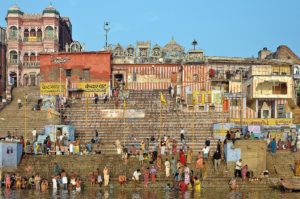Varanasi is located in the state of Uttar Pradesh, India, and is known as the epicenter of death for Hindus. The city, and its famous burning ghats, are located directly along the shores of The Ganges, a 1,500-mile long river that has been a lifeline to millions of Indians, as well as a sacred body of water to Hindus.

Man bathing in the Ganges
The city of Varanasi does not hide death. In fact, death is on display 24 hours a day, seven days a week. Through the act of cremation, the bodies of the dead are ushered into the next life in a literal blaze of glory.
The Burning Ghats
There are at 84 ghats on the waterfront of Varanasi. Ghats are multipurpose, stone riverbank steps that provide access to the Ganges. Kids, families and sadhus (holy men) use these ghats not only to perform sacred rituals (puja), but also for daily, domestic acts of washing clothes, bathing and swimming.
In between these scenes of home life are two ghats — Manikarnika and Harishchandra. These are the burning ghats, dedicated to the ritual of public cremation. According to Hindu belief, cremation is a major rite of passage. If one dies or is cremated in Varanasi, the soul will be released from the ongoing cycle of rebirth.
The Ritual
First, the body is wrapped in a shroud — usually it is white, but different colors are sometimes used (gold, for a proud, elderly death; red flecked with yellow for high-caste women who die before their husbands). Women aren’t allowed on the funeral pyre. This reflects old customs of India, including the now-outlawed practice of Sati.

Ghats on the Ganges
Next, the chief mourner (typically the dead person’s eldest son), holds a sheaf of straw with an ember on it. The men walk counterclockwise around the pyre five times, representing the elements of fire, water, earth, air and ether. Finally, the chief mourner places the smoldering ember on wood shavings atop the body. The body ignites and begins to burn, taking approximately three hours to be completely consumed.
There are five types of people who can’t be cremated: pregnant women, children, sadhus, lepers, and people bitten by a cobra. Instead, these individuals are wrapped in a shroud, tied to a rock, and then dropped into the Ganges.
Death In India
In Hinduism, death and life are not permanent. Hindus view the soul as immortal. Consequently, the soul must work through many lives until it achieves a state of equanimity. It is the Burning Ghats in Varanasi that offer a soul liberation. Here, the dead find “the path of the sun,” skip the endless cycle of reincarnation, and go straight to nirvana.

 The Burning Ghats in Varanasi, India
The Burning Ghats in Varanasi, India


 How Dare You Die Now!
How Dare You Die Now!
 Debating Medical Aid in Dying
Debating Medical Aid in Dying
 “Help Me, Helen”
“Help Me, Helen”














